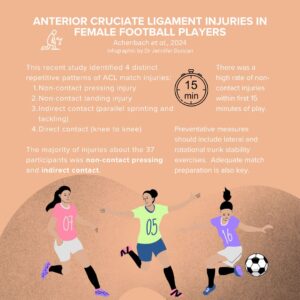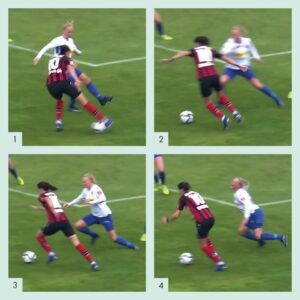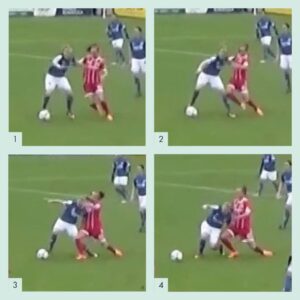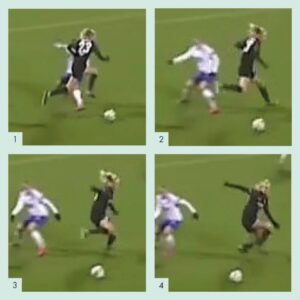Keywords: soccer; video analysis; mechanism.
This blog summarises a recently published paper assessing distinct ACL injuries in professional female footballers (1).
Why is this study important?
Anterior cruciate ligament (ACL) injuries are a well-known problem in football and show a multiple times increased incidence in female football (2). This is of particular interest with increasing popularity of football among female athletes. The more known about the cause and mechanism of the injury, will theoretically prevent this injury in the future (3). There are multiple reports of the mechanism of ACL injuries in male footballers, but there is a lack of information among a more high risk population of female footballers (4, 5).
How did the study go about this?
This study used a prospective design to analyse all ACL injuries in female professional football (first division) in Germany between 2016-17 and 2022-23 season. Injuries were identified using media analysis and video material of the incident was collected. A reviewer team of experts in professional football analyzed the injury situation according to a standardized protocol. Epidemiological and injury data, as well as the medical history of ACL tears, were obtained from media reports and the statutory accident insurance for professional athletes.
What did the study find?
Thirty-seven ACL injuries were included into this analysis. 46% were classified as no contact, 38% as indirect contact injury and 16% were reported as direct contact. Most injuries (80%) occurred during horizontal movements such as sprinting (26%), change-of-direction manoeuvres (19%), stopping (14%) and lunging (14%).
The main finding from this study was the identification of four distinct repetitive patterns of ACL match injuries: (1) non-contact ’pressing ACL injury’ (n=9), (2) indirect contact ’parallel sprinting and tackling ACL injury’ (n=7), (3) direct contact ’knee-to-knee ACL injury’ (n=6) and (4) non-contact ’landing ACL injury’ (n=4). Interestingly 41% of all reported non-contact injuries occurred in the first 15 minutes of the match.
What are the key take-home points?
The results of this prospective study on video analysis in German professional female football identified four common mechanisms of ACL injuries. The injuries show a great potential of prevention due to its mainly non-contact and indirect contact pattern. Preventive measures should include lateral and rotational trunk stability exercises, as well as one-legged stance during sprinting and upper-body contact with rotation. Players should be also taught and practice alternative landing and tackling techniques for an application in high-risk situations. Simultaneously timing was identified as a relevant risk factor, due to the high rate of non-contact injuries within the first 15 minutes of the match. Adequate match preparation, load management and sufficient neuromuscular activation are proper ways for a prevention of this high-risk period.

ACL injury illustrations:

Figure 1: Illustration of the ACL injury pattern in women’s professional football: ‘pressing ACL injury’. The blue-white player’s left knee was injured in this situation. (1) The defending player is running towards the opponent in possession of the ball. (2) She changes direction with a non-contact sidestep cut. (3) Assumed injury frame. (4)Loss of balance. ACL, anterior cruciate ligament
Figure 2: Illustration of the ACL injury pattern in women’s professional football: ‘parallel sprinting and tackling knee injury’. The blue-white player’s left knee was injured in this situation. (1) Parallel sprinting duel towards the ball. (2) Upper-body tackle and indirect mechanical perturbation while the left leg is on the ground. (3) Assumed injury frame. (4) Loss of balance. ACL, anterior cruciate ligament.

Figure 3: Illustration of the ACL injury pattern in women’s professional football: ‘knee-to-knee injury’. The blue-white player’s left knee was injured in this situation. (1) Player versus player duel with the defender shielding the ball. (2) She is tackled from behind with a direct lateral impact to the knee joint. (3) Assumed injury frame. (4) Loss of balance. ACL, anterior cruciate ligament

Figure 4: Illustration of the ACL injury pattern in women’s professional football: ‘landing ACL injury’. The black player’s left knee was injured in this situation. (1) Jump over a defender. (2) Non-contact landing with the left leg and visual/neurocognitive perturbation with the head following the ball. (3) Assumed injury frame. (4) Loss of balance. ACL, anterior cruciate ligament
References:
- Achenbach L, Bloch H, Klein C, et alFour distinct patterns of anterior cruciate ligament injury in women’s professional football (soccer): a systematic video analysis of 37 match injuries British Journal of Sports Medicine 2024;58:709-716.
- Waldén M, Hägglund M, Werner J, et al. The epidemiology of anterior cruciate ligament injury in football (soccer): a review of the literature from a gender-related perspective. Knee Surg Sports Traumatol Arthrosc 2011;19:3–10.
- Finch C. A new framework for research leading to sports injury prevention. J Sci MedSport 2006;9:3–9.
- Waldén M, Krosshaug T, Bjørneboe J, et al. Three distinct mechanism predominate in non-contact anterior cruciate ligament injuries in male professional football players: a systematic video analysis of 39 cases. Br J Sports Med 2015;49:1452–60.18
- Della Villa F, Buckthorpe M, Grassi A, et al. Systematic video analysis of ACL injuries in professional male football (soccer): injury mechanism, situational patterns and biomechanics study on 134 consecutive cases. Br J Sports Med 2020;54:1423–3
Authors: Dominik Szymski, Leonard Achenbach